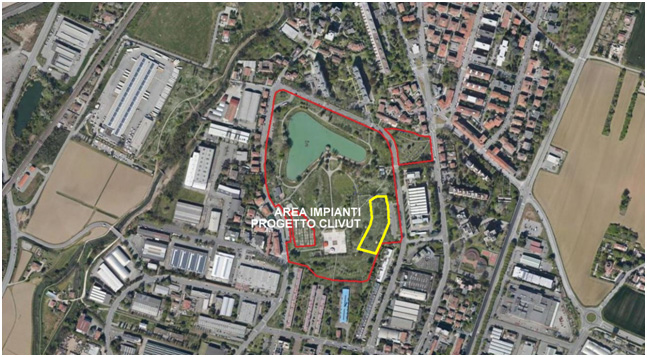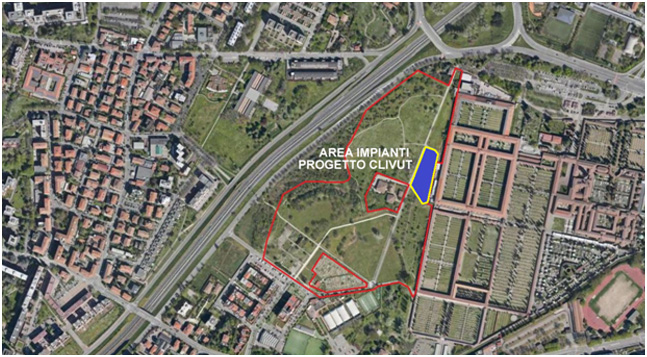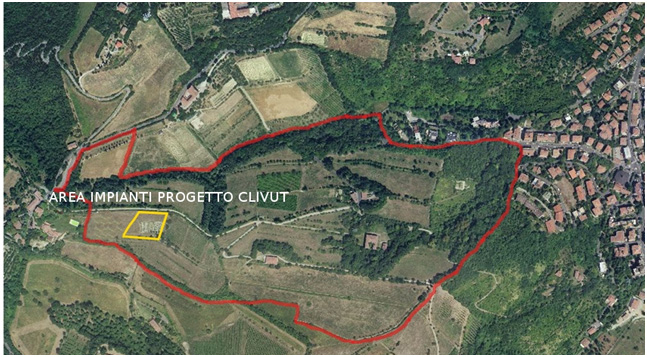- Email : info@lifeclivut.eu
Πιλοτικές πόλεις \ Bologna
Bologna
PARCO DEI GIARDINI – GIARDINO DELLA CÀ BURA (44°32'20.90"N, 11°21'15.67"E)
A green area of about 10 hectares located between via dell'Arcoveggio and via dei Giardini, close to the Navile canal and the historical centre of Corticella, where new and imposing residential settlements alternate with groups of smaller houses, mostly built before the last war. The park develops around a central axis which, between two large elongated humps, connects a paved square with a gazebo that juts out over a large pond. The pond is the heart of the park and its presence is a reminder of the period when, from the middle of the last century, in the area surrounding the Navile canal, between the Battiferro lock and Corticella, numerous kilns were built and the vast areas used as clay quarries, once abandoned, ended up flooding.
PARCO NICHOLAS GREEN (44°29'50.02"N, 11°18'12.98"E)
Nicholas Green Park is a triangle of greenery stretching between the 1989 axis (which is invisible and silent) and the Certosa cemetery. It used to be the park of Villa Contri, in memory of the manor house that stood here, but for the last ten years it has been named after the American boy who was killed in 1994 (when he was only 7 years old) on the A2 Naples-Reggio Calabria motorway near Vibo Valentia, while he was travelling in Italy on his way to Sicily with his parents; the car in which they were travelling was accidentally mistaken for that of a jeweller by some robbers who attempted a robbery.
PARCO DI VILLA GHIGI (44°28'36.06"N, 11°19'23.99"E)
The park extends for about thirty hectares around an ancient noble villa on the first hills of Bologna, just outside Porta San Mamolo and within sight of the city centre. Ceded to the Municipality in 1972 by the heirs of the last owner, the zoologist Alessandro Ghigi, who had already donated a limited portion in the previous decade, the park is now one of the most pleasant public green areas in the hills of Bologna. The territory is enclosed in the so-called Valverde, a valley cut by the Fontane stream, a tributary of the Aposa torrent, which is bounded to the north by the Osservanza hill, with its imposing convent and Villa Aldini, and to the south by the Ronzano hill, at the top of which stands the ancient hermitage hidden by thick woodland.



Πράσινα περιουσιακά στοιχεία της Μπολόνια
Οι δημόσιες πράσινες περιοχές του Δήμου της Μπολόνια ανέρχονται
σε περίπου 1.050 εκτάρια, που αντιστοιχούν στο 8% περίπου
της συνολικής επέκτασης του δημοτικού εδάφους. Η δημοτική
πράσινη κληρονομιά είναι οργανωμένη σε πάρκα και κήπους, σε
εκτεταμένες περιοχές (κυρίως στα βουνά και κατά μήκος του
ποταμού), σε χώρους πρασίνου σχολείων, σε περιοχές που συνδέονται
με δημόσια κτίρια και αθλητικά κέντρα, αλλά και σε πράσινες
περιοχές αστικών επίπλων, με ιδιαίτερη αναφορά για τις περιβαλλοντικές
λωρίδες που πλαισιώνουν τους κύριους δρόμους πρόσβασης στην
πόλη.
Σχεδόν το 70% των πράσινων περιουσιακών στοιχείων αποτελείται
από εξοπλισμένους χώρους πρασίνου, δηλαδή χώρους κατάλληλους
για χρήση από τους πολίτες. Τα μεγάλα και εκτεταμένα πάρκα
που βρίσκονται στους λόφους στα νότια της πόλης και κατά μήκος
των υδάτινων ποταμών που τρέχουν στην αστική περιοχή (ο χείμαρρος
Savena στα ανατολικά και ο ποταμός Ρήνος στα βόρεια) ξεχωρίζουν
για το μέγεθός τους.
Αυτά συνοδεύονται από πολλά μεγάλα αστικά πάρκα, μερικά από
τα οποία είναι ιστορικά (Giardini Margherita, Parco della
Montagnola, Villa Spada και Villa delle Rose, για να αναφέρουμε
μόνο μερικά), ενώ άλλα έχουν μοντέρνο σχεδιασμό, όπως το Pier
O parque Paolo Pasolini, Nicholas Green park ή εκείνα της
Via dei Giardini (περιοχή Ca'Bura). Μερικές εκατοντάδες κήποι
και μικροί κήποι μεγάλης σημασίας στη γειτονιά συμπληρώνουν
τα πλεονεκτήματα των εξοπλισμένων πρασίνου.
Μέσα στις καταπράσινες περιοχές και στους δρόμους της πόλης,
υπάρχουν περισσότερα από 84.000 δέντρα που μελετήθηκαν ξεχωριστά,
εκ των οποίων τα 18.000 σκιάζουν τους δρόμους της πόλης. Εκτός
από αυτήν την πλούσια προσφορά δέντρων, υπάρχουν επίσης δέντρα
που βρίσκονται σε θραύσματα δασών, κυρίως σε πάρκα πλαγιά,
όπου εκτιμάται ότι υπάρχουν άλλα 40.000 δέντρα.
Εκτός από τη δημόσια βλάστηση, υπάρχει επίσης ιδιωτική διακοσμητική
βλάστηση, δηλαδή, βλάστηση που βρίσκεται στη γη και τους κήπους
των σπιτιών (βίλες, σαλέ, συγκυριαρχίες) που καλύπτει μια
περιοχή παρόμοια με εκείνη της δημόσιας βλάστησης. Ως αποτέλεσμα,
περισσότερο από το 15% του δημοτικού εδάφους καλύπτεται από
καλλωπιστική βλάστηση. Η παροχή ιδιωτικής βλάστησης επικεντρώνεται
ιδιαίτερα σε ορισμένες περιοχές της Μπολόνια, οι οποίες, λόγω
αυτού του χαρακτηριστικού, έχουν πάρει το όνομα "πόλεις κήπων".
Parco 11 settembre 2001 - Urban Park
The garden is enclosed by the wall of a former tobacco factory,
established in 1801 on the site of a former convent. The tobacco
fatory’s production facilities, which were bombed during the
Second World War, were later demolished, thus becoming a public
garden in 1981. Its tree vegetation consists mainly of linden,
elm and field maple trees. A large polycormic plane tree to
the south of the garden is noteworthy. The current name of
the Park is a reminder of the tragedy of the 2001 terrorist
attacks in the United States.

Giardini Margherita - Historical Gardens
It is the largest and most popular urban park in the city.
Designed by the Piedmontese Ernesto Balbo Bertone di Sambuy
to provide Bologna with a large public green space, similar
to those in major Italian and European cities. It was inaugurated
in 1879 as the Passeggio Regina Margherita (wife of King Umberto
I). The park retains part of its original appearance, vaguely
inspired by the great romantic English parks, with wide tree-lined
avenues, a small lake with mock wide tree-lined avenues, a
pond with fake chalk cliffs, vast areas of lawn, oak groves
and other more natural corners, an array of remarkable, mainly
exotic tree species (cedars, pines, horse chestnuts, plane
trees, bald cypresses, a sequoia and some oak trees). On the
southern side of the lake, is the short open-air stretch of
the ancient Savena canal, one of the waterways that characterised
the city in the Middle Ages. There are facilities of all kinds:
well- equipped playgrounds for kids, a Youth Centre and annexed
volleyball and basketball courts. Benches, drinking water
fountains, ice cream kiosks and tennis courts make the park
a popular meeting place.

Villa Bernaroli - Cultivated Public Areas
Villa Bernaroli, a late 17th-century manor house and adjacent
area, is the focus of cultural and rehabilitation activities
in an area of about 50 ha, including farmland, farm buildings
and one of the largest horticultural areas managed by the
municipality of Bologna. The rural landscape, which is still
easily recognisable, preserves numerous field maple trees
with 'married' vines at the edges of the fields and the presence
of isolated farnias, poplars and elms. Since 2013, this intra-urban
green area has been part of the "Parco Città Campagna" project,
which aims to enhance and make more usable a vast area of
the plains west of Bologna, between the Reno river and the
Samoggia stream. Financed by the Emilia-Romagna Region, the
project aims at promoting local agriculture and recovering
the minor roads as tools to strengthen the identity of the
rural peri-urban area and enhance the landscape and historical-cultural
heritage. Four centralities have been defined (including Villa
Bernaroli), which represent the main elements of identity
and attraction for the area, connected by a network of bicycle
and pedestrian paths, which allow to reach the most valuable
areas and farms in the area:
- Total surface area: 7,300 hectares
- Tength of the route: 30 km.

Scuole Grosso - School Green
Parco Grosso is a large school green space, to which the Grosso
nursery and kindergarten belong, as well as the Children's
and Parents' Centre and Children's Space "Via del Grosso Tasso".
The presence of an open-air teaching room, managed by the
Ghigi Foundation, makes it possible to carry out garden work,
clay creations, insect nests to build and twigs to animate.
There are also gardens in boxes and small ships to sail in
the former swimming pool.
The park is adjacent to the Grosso primary school and the
Nuova Navile nursery school of the Istituto Comprensivo 5.

Orto botanico dell’Unive rsità di Bologna – Alma Mater
Studiorum - Botanical Garden
The Botanical Garden of Bologna is located in the heart of
the university area. Founded in the 16th century, it is one
of the oldest in Europe.
The green area, with a rectangular plan, reaches the ancient
city walls. It houses particularly valuable thematic collections
and reconstructions of natural environments such as a floodplain
wood, a pond and a rock garden. The Botanical Garden also
has four greenhouses, two tropical and two succulent. A small
greenhouse houses a collection of insectivorous plants. The
museum area houses a herbarium with more than 130,000 plant
specimens, including the precious collections of Ulisse Aldrovandi
and Antonio Bertoloni.

Verde annesso al Centro Commerci ale ‘Meraville’ -
Commercial green areas for public use
Established in the first decade of 2000, at the same time
as the opening of the Meraville shopping park, the green area
is made up of two typologies. The first one for furnishing
and shading the parking areas and consisting of ornamental
tree and shrub species such as flowering pear trees, albizzie,
hybrid poplar trees, lime trees, holm oaks and tamarisk trees.
The second is a large artificial green hill with a large use
of trees and shrubs selected from the autochthonous flora,
including field maples, manna ashes, baguettes and plants
of landscape and agricultural value such as the cypress poplar,
planted in rows along Via San Donato.
On the top of the hill in 2018, a selection of fruit tree
cultivars in old local varieties were planted.

Cimitero monumentale della Certosa - Cemetery Green
The municipal cemetery was established in 1801 by reusing
the pre-existing structures of the Certosa di San Girolamo
di Casara, founded in the mid- fourteenth century, suppressed
in 1797 by Napoleon, and whose Church of San Girolamo is still
in use. The strong passion of the nobility and the bourgeoisie
for the construction of family tombs turned the Charterhouse
into a veritable "open- air museum", a stop on the Italian
Grand Tour: Chateaubriand, Byron, Dickens, Mommsen and Stendhal
all visited it. With about 2,500 trees, the cypress is the
dominant one, followed by yews, tuje, other conifers and ornamental
deciduous trees.

Arredo verde ‘Asse Attrezzato’ di collegame nto tra
Bologna e Casalecchio di Reno - Street Green
The so-called 'Asse Attrezzato Sud-Ovest', is a link road
built in the 1970s, following and adapting to the times the
project for a ring road already provided for in Bologna's
first Regulatory Plan of 1889. The Bologna section is about
2.5 km long, starting north from the Prati di Caprara area
and south with the bridge over the Reno river, with two separate
carriageways and three lanes of traffic each, and is almost
entirely built in a trench.
Two large roundabouts and the side embankments are the green
road furniture consisting mainly of grassy areas and occasional
patches of trees (poplars, holm oaks, Atlas cedars, etc.)
alternating with informal hedges of laurel, lentigo, forsythia
and lagerstroemia.

Villa Mazzacorati / Giardino Ferruccio Busoni - Private
Park for Public Use
The villa today is owned by the Bologna Health Agency. The
villa has always been surrounded by a vast garden, whose thick
vegetation use to be vast in the surrounding estate, now much
reduced. In front of the villa there are traces of an "Italian
style" garden, with a fountain, some specimens of holm oaks,
yews, cedars and thorny oranges. There is also a small greenhouse
housing a collection of tropical orchids.

Villa Ghigi - Nature Trail
The park extends for about thirty hectares around an ancient
noble villa on the first hills of Bologna, in view of the
city centre. Ceded to the municipal administration in 1972
by the heirs of the last owner, the zoologist Alessandro Ghigi,
the park is now one of the most pleasant public green areas
in the hills around Bologna. The territory is enclosed in
the so-called Valverde, a valley cut by the Fontane stream,
a tributary of the Aposa torrent, which is bounded to the
north by the Osservanza hilli, and to the south by the Ronzano
hill, at the top of which stands the ancient hermitage hidden
by thick woodland.
The villa is flanked by the small caretaker's house, now used
as a refreshment point, near which is the old ice-house.
Wide meadows marked by rows of old fruit trees and long grassy
hollows occupy most of the area, which also includes a few
vineyards and various wooded patches, different in origin
and characteristics, with strips of natural woodland and more
recent plantings. A relict but interesting beech wood stands
out, surrounded by strips of oak woodland, planted at the
end of the 19th century and now reserved for guided tours.
Both the meadows and the wooded areas are characterised by
a great floristic richness, already documented in scientific
works of the last century. In the central area of the park,
the compact frame of ornamental greenery stands out, with
numerous exotic evergreen species and majestic trees, which
surrounds the uninhabited villa. Evidence of the area's strong
agrarian connotation is also the presence of two farmhouses,
including the Palazzino, now restored and home to the Villa
Ghigi Foundation, which has been managing the park since 2004.
The Palazzino is also a support point for the educational
activities for schools organised by the Foundation. Thanks
to careful management aimed at safeguarding spontaneous species
and to a series of extraordinary interventions on the paths
and the surface water regulation network, the park has now
regained its past charm and expresses its full potential.









